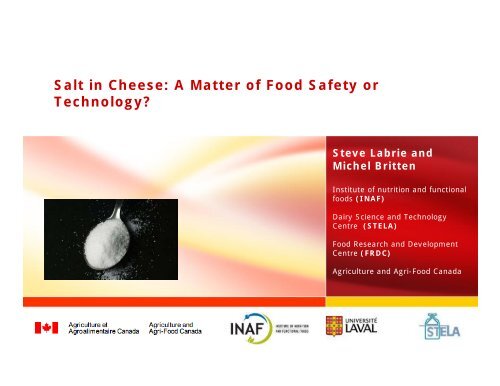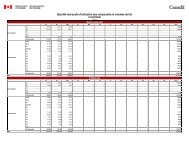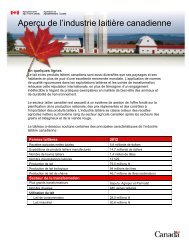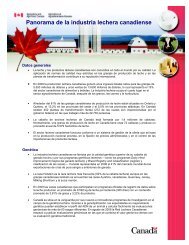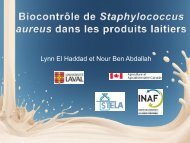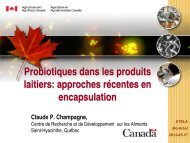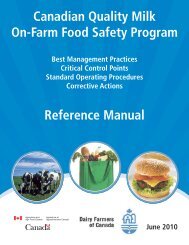Salt in Cheese: A Matter of Food Safety or Technology?
Salt in Cheese: A Matter of Food Safety or Technology?
Salt in Cheese: A Matter of Food Safety or Technology?
You also want an ePaper? Increase the reach of your titles
YUMPU automatically turns print PDFs into web optimized ePapers that Google loves.
<strong>Salt</strong> <strong>in</strong> <strong>Cheese</strong>: A <strong>Matter</strong> <strong>of</strong> <strong>Food</strong> <strong>Safety</strong> <strong>or</strong><strong>Technology</strong>?Steve Labrie andMichel BrittenInstitute <strong>of</strong> nutrition and functionalfoods (INAF)Dairy Science and <strong>Technology</strong>Centre (STELA)<strong>Food</strong> Research and DevelopmentCentre (FRDC)Agriculture and Agri-<strong>Food</strong> Canada
The research team• Fl<strong>or</strong>ie Aguer• Esthelle Berthet-Rayne• Josiane Caplette• Joanie Côté• Carl Cyr• Kathya Dupont• Vanessa Duval-Tougas• Valérie Goulet-Beaulieu• August<strong>in</strong> Goblet• Davy Grava• Just<strong>in</strong>e Hell• Viola<strong>in</strong>e Jan• Ingrid Kombou• Geneviève Lanouette• Marie-Hélène Lessard• Léa Maire• Geneviève Savoie• Emmanuelle Stephan• Émilie Tétreault• Marilyne Touchette• Marc-André Therrien• Mariette Beaudet• Gaétan Bélanger• Francis Boileau• Annie Caron• Nancy Gravel<strong>in</strong>e• Brïte Pauchet• Nathalie Rémillard• Sophie Turcot• Cather<strong>in</strong>e Viel• Michel Britten• Ismail Fliss• Jac<strong>in</strong>the F<strong>or</strong>t<strong>in</strong>• Steve Labrie• Daniel St-Gelais2
A project from the Dairy Cluster I3
HighlightsA. Why reduce sodium <strong>in</strong> food supply?1. Nutritional aspects2. The Health Canada’s sodium reduction strategyB. Challenges <strong>of</strong> sodium reduction <strong>in</strong> cheeses1. Roles <strong>of</strong> salt <strong>in</strong> food <strong>in</strong> cheese safety2. Technological role <strong>of</strong> sodium <strong>in</strong> cheese4
A. Why reduce sodium <strong>in</strong> thefood supply?5
A.1- Sodium <strong>in</strong> food - Nutritional aspects• Sodium is conta<strong>in</strong>ed <strong>in</strong> salt andmany other <strong>in</strong>gredients• Sodium is essential <strong>in</strong> humandiet hav<strong>in</strong>g many physiologicalrolesExcess <strong>of</strong> sodium, daily <strong>in</strong>take <strong>of</strong> 3 400 mg Na / dayNa excessHigh bloodpressure• CVD• Stroke• Kidney diseasesSources: Sodium reduction strategy f<strong>or</strong> Canada. Marilyne Touchette (2013)6
Sodium reduction strategy f<strong>or</strong> CanadaActual sodium <strong>in</strong>take : 3 400 mg / dayObjective 2016 : UL = 2 300 mg / day• Awarness and education• [Na] processed foods• Research• Monit<strong>or</strong><strong>in</strong>g and evaluationSource: Marilyne Touchette, Sodium reduction strategy f<strong>or</strong> Canada7
Contribution <strong>of</strong> processed food8Source: Sodium reduction strategy f<strong>or</strong> Canada
B. Challenges <strong>of</strong> Sodium Reduction<strong>in</strong> <strong>Food</strong> Supply10
IV. The roles <strong>of</strong> salt <strong>in</strong> cheese1. Acts as a barrier aga<strong>in</strong>st pathogens2. Controls starter activity3. Modulates secondary fl<strong>or</strong>a and ripen<strong>in</strong>g fl<strong>or</strong>a4. Affects the activity <strong>of</strong> enzymes that areresponsible f<strong>or</strong> ripen<strong>in</strong>g5. Controls the texture and functionalproperties <strong>of</strong> cheese6. Controls syneresis and moisture7. Adds to the taste11
Our research projectNatural cheeses, sodium reduced cheeses and salt substitutionSpeciality cheesesCheddarMozzarellaMicrobiological effect- Pathogens- Useful bacterial micr<strong>of</strong>l<strong>or</strong>a-Starters- Adjunct cultures- Useful fungal micr<strong>of</strong>l<strong>or</strong>aPhysico-Chemical effect- M<strong>in</strong>eral equilibrium- Texture control- <strong>Salt</strong> distribution- Cohesion- <strong>Salt</strong> replacement- Melt<strong>in</strong>g propertiesÉvaluationsens<strong>or</strong>ielle- Texture- Sens<strong>or</strong>y pr<strong>of</strong>ile- Cohesiv<strong>in</strong>ess- Élasticity12
Hurdles aga<strong>in</strong>st pathogens• The pathogens growth could be affected bymany hurdles.pH13
Effect <strong>of</strong> sodium reduction on themicr<strong>of</strong>l<strong>or</strong>a• Pathogenic bacteria• Listeria monocytogenes• Staphylococcus aureus• Lactic acid bacteria• Lactococci• Lactobacilli• Streptococci• Fungal micro<strong>or</strong>ganisms• Penicillium camemberti• Geotrichum candidum14
<strong>Cheese</strong> model curd• Camembert• Cheddar15
L. monocytogenes -Camembert914 o C, 95% RH 4 o CListeria monocytogenes (log cfu/g)87654320 5 10 15 20 25 30 35Ripen<strong>in</strong>g time (days)16
Listeria monocytogenes - Cheddar17
<strong>Salt</strong> is not a maj<strong>or</strong> growth hurdlef<strong>or</strong> L. monocytogenes• NaCl reduction up to 30 % <strong>in</strong> Cheddar andCamembert cheeses generate similare growthpr<strong>of</strong>iles.• New questions:• Other pathogens and spoil<strong>in</strong>g bacteria?• In « real » cheese?18
In real cheese?19
Consequences <strong>of</strong> salt reductionpH20
Consequences <strong>of</strong> salt reductionpH21
Consequences <strong>of</strong> salt reductionpH22
Consequences <strong>of</strong> salt reductionpH23
Consequences <strong>of</strong> salt reductionpH24
Partial conclusion• <strong>Salt</strong> is a m<strong>in</strong><strong>or</strong> hurdle f<strong>or</strong> the growth <strong>of</strong> Listeriamonocytogenes and Staphylococcus aureus.• <strong>Salt</strong> have an impact on the bacterial startercultures and the observed activity is stra<strong>in</strong>dependent• Fungal ripen<strong>in</strong>g culture seems only lightlyaffected by salt reduction.25
B.2- Technological roles <strong>of</strong> sodiumImpact <strong>of</strong> salt on cheese qualityTaste• Direct effect: salty taste• Indirect effect: enzyme activity• Proteolysis ↓ (especially ‐case<strong>in</strong>)Texture• Physicochemical contribution• <strong>Cheese</strong> salt<strong>in</strong>g: osmotic pressure (humidité ↓)• Prote<strong>in</strong> hydration• Swell<strong>in</strong>g (free water ↓)• Emulsify<strong>in</strong>g activity (free oil ↓)• Colloidal calcium• Cation exchange ???• Enzymatic contribution• Proteolysis ↓26
Impact <strong>of</strong> salt on cheese qualityCol<strong>or</strong>• Decrease whiteness• Swell<strong>in</strong>g and fusion <strong>of</strong> paracase<strong>in</strong> « particles »(reduced <strong>in</strong>terfacial area)… In addition to the salty taste,<strong>Salt</strong> reduces:-bitterness-moisture-free oil-opacity<strong>Salt</strong> <strong>in</strong>creases:-firmness<strong>Salt</strong> controls:-ripen<strong>in</strong>g(texture and flav<strong>or</strong>)27
Impact <strong>of</strong> salt on cheese rheology• Experimental approach• Pilot plant cheese productions• Target [NaCl]: 1.9, 1.6, 1.3%• <strong>Cheese</strong> analysis• Frequency sweep test at 22°C• Melt<strong>in</strong>g pr<strong>of</strong>ile (5 à 90°C)• Rigidity complex modulus (G*) at 22°C• Melt<strong>in</strong>g temperature (G’ = G”)• Rigidity complex modulus(G*) at 75°C (melt)28
Impact <strong>of</strong> salt on cheese rheology• ResultsRigidity modulus 22°C18017070Melt<strong>in</strong>g temperatureRigidity modulus 75°C3,53,0G* 22°C (Kpa)16015014013012020%Temperature °C6560555°CG* 75°C (Kpa)2,52,01,51,060%1100,51001,9% 1,6% 1,3%[NaCl] %501,9% 1,6% 1,3%[NaCl] %0,01,9% 1,6% 1,3%[NaCl] %[NaCl] decrease from 1.9 to 1.3%1.7% moisture <strong>in</strong>crease29
Model system to control cheese m<strong>in</strong>eralcomposition• Diffusion cell• Production <strong>of</strong> non salted cheese• Cutt<strong>in</strong>g <strong>of</strong> cheese disc• Diffusion treatmentDiffusion buffer (UF whey permeate)Non salted cheese disc(70 x 3 mm)• <strong>Salt</strong> is added to diffusion buffer tomeet salt content target• Control f<strong>in</strong>al disc weight (moisture)• Vacuum packag<strong>in</strong>g and saltdistribution equilibrium (4°C)Optimal conditions• Temperature 22°C• Contact time 60 m<strong>in</strong>• Orbital shak<strong>in</strong>g 50 rpm30
Model system to control cheese m<strong>in</strong>eralcomposition• Diffusion cell• Amount <strong>of</strong> salt added to the bufferto meet salt/moisture target <strong>in</strong>cheese[NaCl] buffer = (S/M target – 0.736)/0.498R 2 =0.9873• Moisture controlS/M (%)4,03,53,02,52,01,51,0• Control calcium equilibrium• Use <strong>of</strong> CaCl 2 , NaCit,phosphates…0,50,00 1 2 3 4 5[NaCl] buffer (%)31
Impact <strong>of</strong> salt and calcium equilibrium on cheesetexture (constant moisture)• Experimental approach• Fact<strong>or</strong>ial experimental design• [NaCl] <strong>in</strong> cheese (5): 0.4 à 2%• Colloidal calcium (3): 10 – 25 mg/g prote<strong>in</strong>• <strong>Salt</strong>s added to diffusion buffer: NaCl, CaCl 2 , NaCit• Analyses• Texture pr<strong>of</strong>ile analysis (TPA)• <strong>Cheese</strong> rheology• Frequency sweep test at 22°C• Melt<strong>in</strong>g pr<strong>of</strong>ile (5 à 90°C)32
Impact <strong>of</strong> salt and calcium equilibrium on cheesetexture (constant moisture)• ResultsTexture at 22°C170,58• Reduction <strong>in</strong> salt 1.75 à 0.35%• ↓ Firmness (25%)• non l<strong>in</strong>ear• ↑ Cohesion (7%)Firmness (N)16151413120,560,540,52Cohesion110,5• Colloidal calciumnon significant effect…21,5 1 0,5[NaCl] (%)033
Impact <strong>of</strong> salt and calcium equilibrium on cheesetexture (constant moisture)• ResultsRheology at 75°C (melt)• <strong>Salt</strong> reduction• ↓ Rigidity modulus• Increase colloidal calcium• ↑ Rigidity modulusG* 75°C (KPa)1,81,61,41,210,80,60,421,5 1 0,5[NaCl] (%)G* 75°C (KPa)1,61,51,41,31,21,110,90,8010 15 20 25[Ca coll ] (mg/g)Colloidal calcium "<strong>of</strong>fsets" the loss <strong>of</strong> viscosity <strong>of</strong> melted cheesecaused by the reduction <strong>of</strong> salt content34
Conclusions• Reduc<strong>in</strong>g salt content <strong>in</strong>duces significant texturechanges <strong>in</strong> cheese (loss <strong>of</strong> firmness, loss <strong>of</strong> meltviscosity);• These changes cannot be expla<strong>in</strong>ed by highermoisture <strong>of</strong> reduced salt cheeses;• Colloidal calcium showed little effect on cheesetexture at room temperature, but significantly<strong>in</strong>creased the viscosity <strong>of</strong> melted cheese.• May c<strong>or</strong>rect melt<strong>in</strong>g defects <strong>of</strong> low salt cheese…35
Thank you !


